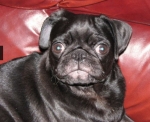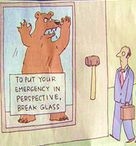I think the figure
90% is being thrown around in multiple contexts in this thread and it's time to clarify what might be meant by that number.
First:
Overflow wrote:
Today sleep technician was trying to dissuade me from ASV by saying it only targeted up to 90% of something. Looking at the literature could she mean
'Sets MV target to 90% of the patient's own ventilation' from AUtoASV mode?
First a definition: MV= minute ventilation is the total amount of air inhaled over a one minute period.
So this 90% is a machine setting on ASV machines: It tells the ASV
when to trigger (initiate) breaths by drastically ramping up the IPAP because the patient is not breathing sufficiently well for
central reasons, not obstructive ones. Part of the problem in central apnea (which ASV is designed to treat) is a CO2 overshoot/undershoot cycle. During the "overshoot" part of the cycle, too much CO2 is blown off and that reduces the respiratory drive and the breaths become shallower and shallower. When the minute ventilation recorded by the machine drops to 90% (or less) of the so called "target minute ventilation", the machine starts triggering breaths by increasing the IPAP and switching between EPAP and IPAP at fixed time intervals. The idea behind this is:
- the drop in minute ventilation is the early heads up that a CO2 overshoot has likely happened and that the breathing is becoming unstable in central fashion; hence the patient may have entered the CO2 undershoot part of the cycle.
- the machine triggered breaths should prevent the CO2 overshoot/undershoot problem spiraling out of control leading to CAs at the nadir of each breathing cycle.
And ASV machine is just as effective as a regular CPAP/APAP/BiPAP/BiPAP Auto when it comes to treating the obstructive events in OSA: If the ASV's EPAP pressure is correctly titrated, it should control the OSA as well as a well titrated CPAP/APAP/BiPAP/BiPAP Auto. If the ASV's EPAP pressure is too low, too many obstructive events can get by the defenses---just like what happens if the pressure of a CPAP (or APAP/BiPAP/BiPAP Auto) is set to low.
Overflow wrote:That seems to imply that the machine can takeover up to 90% of patient's own breating acting as a ventilator,
No. You are misinterpreting stuff here. The ASV machine does not (usually) take over "90% of the patient's own breathing." The "90%" number tells the ASV
when to start acting as a ventilator: If the person's minute ventilation drops below 90% of the target ventilation number, the ventilator part of the ASV kicks in and the machine starts triggering breaths. How much of the time the ASV is triggering breaths and how much time the patient is triggering their own breathing varies quite a bit from patient to patient. But in the ASV reports I've seen posted here, the
patient triggered breaths percentage is usually in the mid to high 80s or low 90s. In other words, it's rare for a properly titrated ASV machine to need to trigger more than 20% of the breaths.
Overflow wrote:but would surely not preclude it from still effectively treating OSA and other apneas up to only 90% efficiency? My theory was that machine does what the others do for OSA but may do it just slightly better as it can adapt to patient's breathing pattern and can greater flexibility with expiratory pressure than EPR.
Again no.
If the ASV's EPAP pressure is correctly titrated then the ASV should be 100% effective in treating OSA, same as a well titrated CPAP.
But the "adapting to the patient's breathing pattern" is tied to how the machine treats the person's
Central Apnea. Part of the ASV algorithm involves allowing the machine to determine a moving MV target value based on the last several minutes of
normal breathing instead of using a predetermined fixed MV target. That helps prevent the ventilator-style part of the algorithm from kicking it too often.
As for "greather flexibility with expiratory pressure than EPR", the answer is "maybe, maybe not." On an ASV machine there is a (often fixed) EPAP pressure setting, a min IPAP (or PS) setting, and a max IPAP (or PS) setting. PS and IPAP are intimately tied to each other: IPAP = EPAP + PS, so min IPAP = EPAP + min PS and max IPAP = EPAP + max PS.
When the breathing is stable (from a CENTRAL point of view), the ASV acts like a bilevel machine (an S9 VPAP or a System One BiPAP) where the pressure cycles back and forth between
EPAP and
min IPAP = EPAP + min PS following the patient's exhalations and inhalations. So if
PS is set to 4 or more, then yes, there will be more expiratory relief than an S9 Elite/AutoSet with EPR = 3. But if
PS is 0, 1, 2, or 3, there will NOT be any more expiratory relief than an S9 Elite/AutoSet with EPR. In any case, the expiratory relief achieved by the
PS setting on the ASV can be obtained on the MUCH cheaper bilevel machines.
So if additional expiratory relief is the primary issue rather than central apnea, the machine of choice would be a plain old bilevel machine, like the the S9 VPAP S, the S9 VPAP Auto, the System One BiPAP Pro, and the System One BiPAP Auto.
We also have
JDS74 wrote:The 90% being referred to is the percentage of folks who have sleep apnea and only have obstructive apneas.
The ASV class of machine is for the less than 1% of patients who have central apneas in a significant number.
The usually cited numbers are that about 10-15% of newly diagnosed OSA patients who are put on CPAP will develop clinically significant problems with
pressure induced central apneas and may meet the clinical definition of
Complex Sleep Apnea. For some of these patients, it may be possible to find a sweet spot for the pressure settings (possibly through APAP or BiPAP or BiPAP Auto) where the pressure used is high enough to decently manage the OSA but low enough to keep the central part of CompSA under control. But for many (possibly most) of the people in this unlucky group of PAPers with CompSA, a good compromise pressure cannot be found, and these folks really need a well tuned ASV machine. The EPAP controls the OSA and the ASV algorithm controls the central part of the CompSA.
Finally I have to agree with JDS74: If you are not having any problems with central apneas, it seems like an ASV would be an awfully expensive way of addressing your problems. If the primary problem with CPAP/APAP is that you're using pressure(s) near the top of the range and/or EPR = 3 is not providing enough expiratory pressure relief, then the appropriate machines to be looking at are the bilevels. On the Resmed side, that means the S9 VPAP S and the S9 VPAP Auto.













